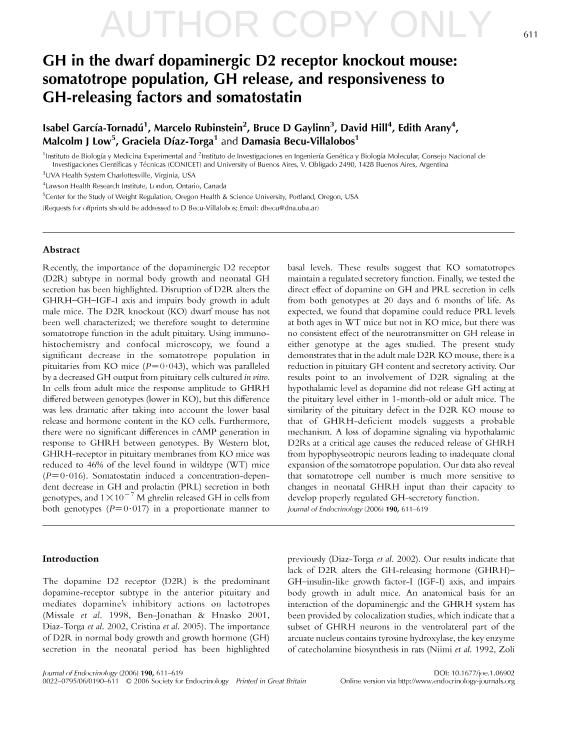Mostrar el registro sencillo del ítem
dc.contributor.author
Garcia Tornadu, Isabel Andrea

dc.contributor.author
Rubinstein, Marcelo

dc.contributor.author
Gaylinn, Bruce
dc.contributor.author
Hill, David
dc.contributor.author
Arany, Edith
dc.contributor.author
Low, Malcom J.
dc.contributor.author
Diaz, Graciela Susana

dc.contributor.author
Becu, Damasia

dc.date.available
2017-11-23T20:42:26Z
dc.date.issued
2006-12
dc.identifier.citation
Garcia Tornadu, Isabel Andrea; Rubinstein, Marcelo; Gaylinn, Bruce; Hill, David; Arany, Edith; et al.; Growth hormone in the dwarf dopaminergic D2R knockout mouse: somatotrope population, GH release and responsiveness to GH-releasing factors and somatostatin; BioScientifica; Journal of Endocrinology; 190; 3; 12-2006; 611-619
dc.identifier.issn
0022-0795
dc.identifier.uri
http://hdl.handle.net/11336/28947
dc.description.abstract
Recently, the importance of the dopaminergic D2 receptor (D2R) subtype in normal body growth and neonatal GH secretion has been highlighted. Disruption of D2R alters the GHRH-GH-IGF-I axis and impairs body growth in adult male mice. The D2R knockout (KO) dwarf mouse has not been well characterized; we therefore sought to determine somatotrope function in the adult pituitary. Using immunohistochemistry and confocal microscopy, we found a significant decrease in the somatotrope population in pituitaries from KO mice (P=0.043), which was paralleled by a decreased GH output from pituitary cells cultured in vitro. In cells from adult mice the response amplitude to GHRH differed between genotypes (lower in KO), but this difference was less dramatic after taking into account the lower basal release and hormone content in the KO cells. Furthermore, there were no significant differences in cAMP generation in response to GHRH between genotypes. By Western blot, GHRH-receptor in pituitary membranes from KO mice was reduced to 46% of the level found in wildtype (WT) mice (P=0.016). Somatostatin induced a concentration-dependent decrease in GH and prolactin (PRL) secretion in both genotypes, and 1x10(-7) M ghrelin released GH in cells from both genotypes (P=0.017) in a proportionate manner to basal levels. These results suggest that KO somatotropes maintain a regulated secretory function. Finally, we tested the direct effect of dopamine on GH and PRL secretion in cells from both genotypes at 20 days and 6 months of life. As expected, we found that dopamine could reduce PRL levels at both ages in WT mice but not in KO mice, but there was no consistent effect of the neurotransmitter on GH release in either genotype at the ages studied. The present study demonstrates that in the adult male D2R KO mouse, there is a reduction in pituitary GH content and secretory activity. Our results point to an involvement of D2R signaling at the hypothalamic level as dopamine did not release GH acting at the pituitary level either in 1-month-old or adult mice. The similarity of the pituitary defect in the D2R KO mouse to that of GHRH-deficient models suggests a probable mechanism. A loss of dopamine signaling via hypothalamic D2Rs at a critical age causes the reduced release of GHRH from hypophyseotropic neurons leading to inadequate clonal expansion of the somatotrope population. Our data also reveal that somatotrope cell number is much more sensitive to changes in neonatal GHRH input than their capacity to develop properly regulated GH-secretory function.
dc.format
application/pdf
dc.language.iso
eng
dc.publisher
BioScientifica

dc.rights
info:eu-repo/semantics/openAccess
dc.rights.uri
https://creativecommons.org/licenses/by-nc-nd/2.5/ar/
dc.subject
Dopamine
dc.subject
Gh
dc.subject
Pituitary
dc.subject
Somatostatin
dc.subject.classification
Fisiología

dc.subject.classification
Medicina Básica

dc.subject.classification
CIENCIAS MÉDICAS Y DE LA SALUD

dc.title
Growth hormone in the dwarf dopaminergic D2R knockout mouse: somatotrope population, GH release and responsiveness to GH-releasing factors and somatostatin
dc.type
info:eu-repo/semantics/article
dc.type
info:ar-repo/semantics/artículo
dc.type
info:eu-repo/semantics/publishedVersion
dc.date.updated
2017-11-02T20:12:10Z
dc.identifier.eissn
1479-6805
dc.journal.volume
190
dc.journal.number
3
dc.journal.pagination
611-619
dc.journal.pais
Reino Unido

dc.journal.ciudad
Bradley Stoke
dc.description.fil
Fil: Garcia Tornadu, Isabel Andrea. Consejo Nacional de Investigaciones Científicas y Técnicas. Instituto de Biología y Medicina Experimental. Fundación de Instituto de Biología y Medicina Experimental. Instituto de Biología y Medicina Experimental; Argentina
dc.description.fil
Fil: Rubinstein, Marcelo. Consejo Nacional de Investigaciones Científicas y Técnicas. Instituto de Investigaciones en Ingeniería Genética y Biología Molecular "Dr. Héctor N. Torres"; Argentina
dc.description.fil
Fil: Gaylinn, Bruce. University of Virginia Health System; Estados Unidos
dc.description.fil
Fil: Hill, David. Lawson Health Research Institute; Canadá
dc.description.fil
Fil: Arany, Edith. Lawson Health Research Institute; Canadá
dc.description.fil
Fil: Low, Malcom J.. Oregon Health & Science University; Estados Unidos
dc.description.fil
Fil: Diaz, Graciela Susana. Consejo Nacional de Investigaciones Científicas y Técnicas. Instituto de Biología y Medicina Experimental. Fundación de Instituto de Biología y Medicina Experimental. Instituto de Biología y Medicina Experimental; Argentina
dc.description.fil
Fil: Becu, Damasia. Consejo Nacional de Investigaciones Científicas y Técnicas. Instituto de Biología y Medicina Experimental. Fundación de Instituto de Biología y Medicina Experimental. Instituto de Biología y Medicina Experimental; Argentina
dc.journal.title
Journal of Endocrinology

dc.relation.alternativeid
info:eu-repo/semantics/altIdentifier/url/http://joe.endocrinology-journals.org/content/190/3/611.short
dc.relation.alternativeid
info:eu-repo/semantics/altIdentifier/doi/http://dx.doi.org/10.1677/joe.1.06902
Archivos asociados
